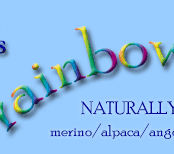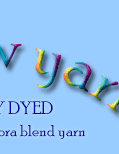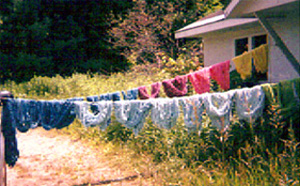





|
Merino/Angora/Alpaca blend yarn is 60% merino (extremely soft wool), 20% angora (bunny rabbits - they're shorn, like sheep are), and 20% alpaca. It is commercially spun, so I receive it as 8 oz. skeins, usually white, but now I also have had a batch of light grey spun, which made the blues, greens and grey color combination possible. I wash, mordant (that's what makes the dye color fast) and then dye it, using the same natural dyes I've always gotten such wonderful colors from. Many of the colors I ply together, changing one color at a time, putting in different amounts of color, so the stripes will be different widths. The other way I put the colors together, is to keep one color the same for the whole skein and just keep changing the second color, this makes the stripes more subtle. Either way, you still have a choice of the brighter shades, or the quieter colors. Also the amount of contrast between each 2 color combination will make a lot of difference in the overall brightness/quietness of the yarn. For yarn with the full rainbow, the amounts and shades of red and yellow are also a major factor of the overall bright or quiet look. Dyes:
Alum and
Tartaric Acid Mordant: All fiber grown and processed in the U.S.
|
|



